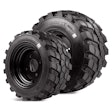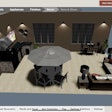Caterpillar proved the value of testing power train components in a full scale, fully integrated simulator when the company developed the ultra class 797 mining truck in the late 1990™s and the 793 mining truck before that. In fact Caterpillar has been using power train simulators for truck development since 1971 when the 85-ton-capacity 777 was in its formative stages. The next generation of mechanical drive and new generation of AC electric drive Cat® truck power trains are benefiting from that long experience and are establishing industry firsts as they undergo rigorous simulator testing.
Following plans announced in March 2006, Caterpillar is developing a new series of mechanical drive mining trucks and a new line of AC electric drive trucks. In making the announcement, Chris Curfman, president of Caterpillar Global Mining and Caterpillar Inc. vice president, said, We are very proud of the strong leadership position that Caterpillar has attained with its mechanical drive trucks, and we™ll continue to invest in strengthening that position. We also recognize that there are unique applications that would make the addition of AC electric drive an important and attractive complement to our current truck line.
Specifically, Caterpillar announced that it will upgrade all mechanical drive mining trucks”785C, 789C, 793D and 797B. Additionally, Cat announced that it will offer two AC electric drive truck models of more than 200 short tons capacity.
One of the first steps in developing the new trucks is the integration of drive train components with the Cat C175 diesel engine, which will power both mechanical and AC electric drive trucks. The state-of-the-art C175 will be available in 12, 16 and 20 cylinder configurations and also will be used in electric power generation. In its new application powering trucks, the C175 produces 2,000 to 4,000 horsepower. It delivers more power from a smaller package and offers improved fuel economy and longer life between rebuilds.
Engineers at the Caterpillar Technology and Solutions Division in Mossville, Illinois, USA, have designed and constructed three full scale power train simulators”two for mechanical drive and one for AC electric drive”to help integrate and validate the C175 and the drive train components that put the power to the wheels. Of course the simulators come into play after extensive computer-based and laboratory-based modeling and simulations during component and software development.
The power train simulators are key components of our comprehensive approach to developing new trucks, said Ed McCord, product manager for large mining trucks. The AC electric drive simulator”the first such simulator to use all of the power train components just as they are in a truck”enables us to test and resolve issues with our proprietary drive system.
The simulators give Caterpillar parallel development paths with prototype trucks and pilot trucks, McCord continued. The simulators effectively improve velocity and responsiveness to field issues and to customer requests.
The two mechanical drive simulators occupy 3,500 square feet of space and the AC electric drive simulator is housed in 1,740 square feet of space. The mechanical drive simulator includes the engine, torque converter, driveshaft, transmission and differential all positioned just as they are on a real truck. Similarly, the AC electric drive simulator, depending on the test, can include the engine, alternator, power inverter, retarding grids, cooling system and wheel motors. Of course both simulators incorporate the electronic controls and software that govern performance of the system, and all components are fully instrumented for monitoring appropriate parameters.
The simulators are invaluable product development tools. They provide a means to optimize component interaction for performance and durability. Remarkably, engineers can determine how the whole drive train is going to perform before it goes into a truck.
The simulators also allow setting up scenarios that closely follow real world applications. This enables engineers to efficiently optimize and validate truck systems, such as transmission shift parameters. The simulators also quickly validate enhancements that could be applied to pilot test trucks. For many years into the future, the simulators will test changes proposed for trucks working in the field.
Caterpillar relies on this leading engineering practice, full scale simulation, to bring better solutions to mining customers faster. Look for the next series of mechanical drive Cat trucks and the new generation of Cat AC electric drive trucks to hit the haul roads running strong.











